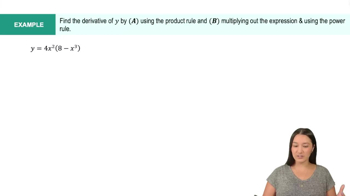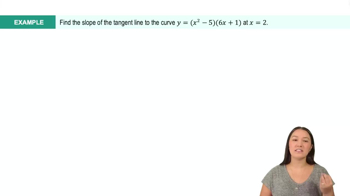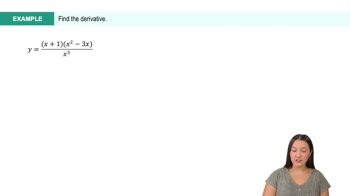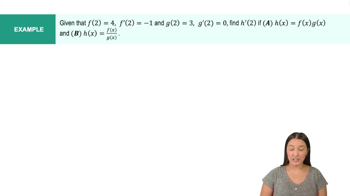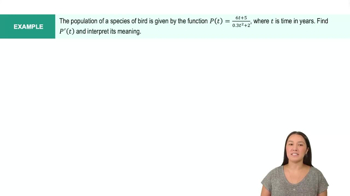Table of contents
- 0. Functions7h 52m
- Introduction to Functions16m
- Piecewise Functions10m
- Properties of Functions9m
- Common Functions1h 8m
- Transformations5m
- Combining Functions27m
- Exponent rules32m
- Exponential Functions28m
- Logarithmic Functions24m
- Properties of Logarithms34m
- Exponential & Logarithmic Equations35m
- Introduction to Trigonometric Functions38m
- Graphs of Trigonometric Functions44m
- Trigonometric Identities47m
- Inverse Trigonometric Functions48m
- 1. Limits and Continuity2h 2m
- 2. Intro to Derivatives1h 33m
- 3. Techniques of Differentiation3h 18m
- 4. Applications of Derivatives2h 38m
- 5. Graphical Applications of Derivatives6h 2m
- 6. Derivatives of Inverse, Exponential, & Logarithmic Functions2h 37m
- 7. Antiderivatives & Indefinite Integrals1h 26m
- 8. Definite Integrals4h 44m
- 9. Graphical Applications of Integrals2h 27m
- 10. Physics Applications of Integrals 2h 22m
3. Techniques of Differentiation
Product and Quotient Rules
Problem 3.4.46
Textbook Question
Derivatives Find and simplify the derivative of the following functions.
h(x) = (x−1)(2x²-1) / (x³-1)
 Verified step by step guidance
Verified step by step guidance1
Step 1: Identify the function as a quotient of two functions, where the numerator is \((x-1)(2x^2-1)\) and the denominator is \(x^3-1\). We will use the quotient rule for derivatives, which is given by \(\frac{d}{dx}\left(\frac{u}{v}\right) = \frac{v \cdot u' - u \cdot v'}{v^2}\), where \(u\) is the numerator and \(v\) is the denominator.
Step 2: Differentiate the numerator \(u = (x-1)(2x^2-1)\) using the product rule. The product rule states that \(\frac{d}{dx}(fg) = f'g + fg'\). Let \(f(x) = x-1\) and \(g(x) = 2x^2-1\). Find \(f'(x)\) and \(g'(x)\), then apply the product rule.
Step 3: Differentiate the denominator \(v = x^3-1\). The derivative of \(v\) is \(v' = 3x^2\).
Step 4: Substitute \(u\), \(u'\), \(v\), and \(v'\) into the quotient rule formula. Simplify the expression obtained from the quotient rule.
Step 5: Simplify the resulting expression further, if possible, by combining like terms and reducing any common factors in the numerator and the denominator.
 Verified video answer for a similar problem:
Verified video answer for a similar problem:This video solution was recommended by our tutors as helpful for the problem above
Video duration:
7mPlay a video:
Was this helpful?
Key Concepts
Here are the essential concepts you must grasp in order to answer the question correctly.
Derivatives
A derivative represents the rate at which a function changes at a given point. It is defined as the limit of the average rate of change of the function as the interval approaches zero. In calculus, derivatives are fundamental for understanding the behavior of functions, including their slopes and rates of change.
Recommended video:

Derivatives
Product Rule
The Product Rule is a formula used to find the derivative of the product of two functions. It states that if you have two functions, u(x) and v(x), the derivative of their product is given by u'v + uv'. This rule is essential when differentiating functions that are multiplied together, as seen in the function h(x) provided.
Recommended video:
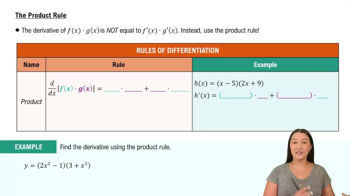
The Product Rule
Quotient Rule
The Quotient Rule is used to differentiate functions that are expressed as the ratio of two other functions. If h(x) = u(x)/v(x), the derivative is given by (u'v - uv')/v². This rule is crucial for the function h(x) in the question, as it involves a division of two polynomial expressions.
Recommended video:
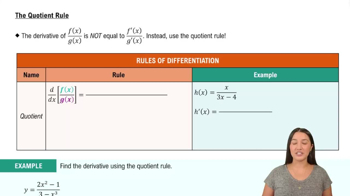
The Quotient Rule
Related Videos
Related Practice



